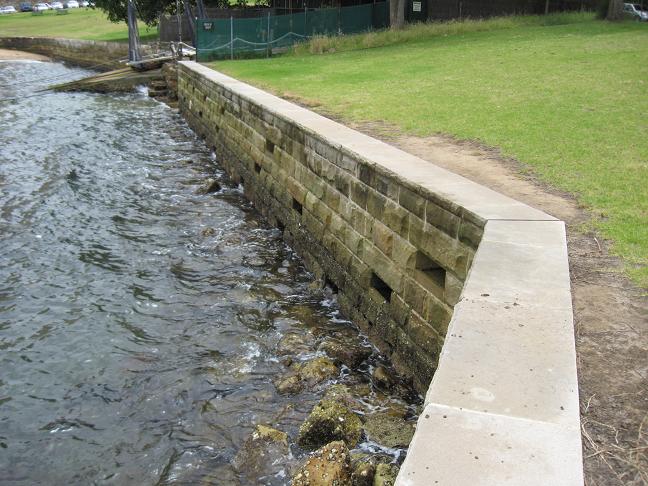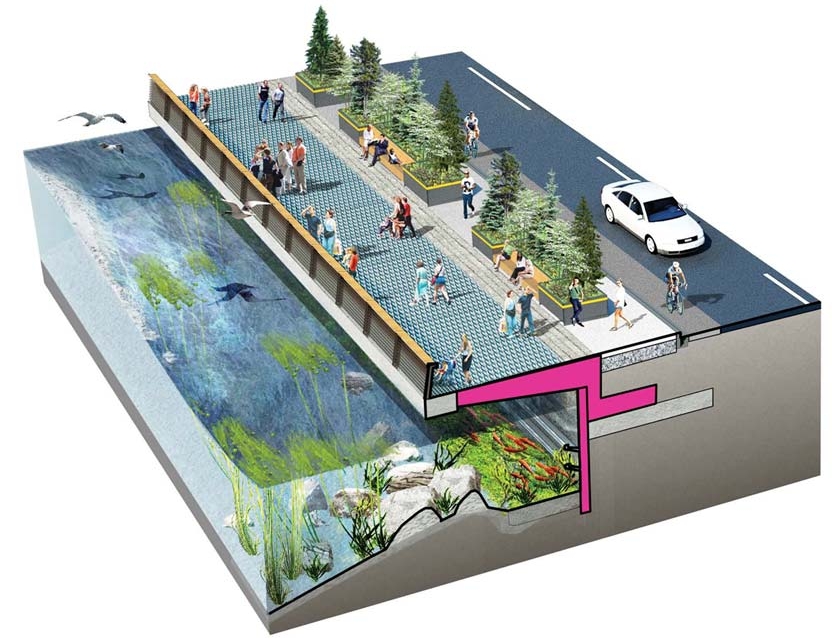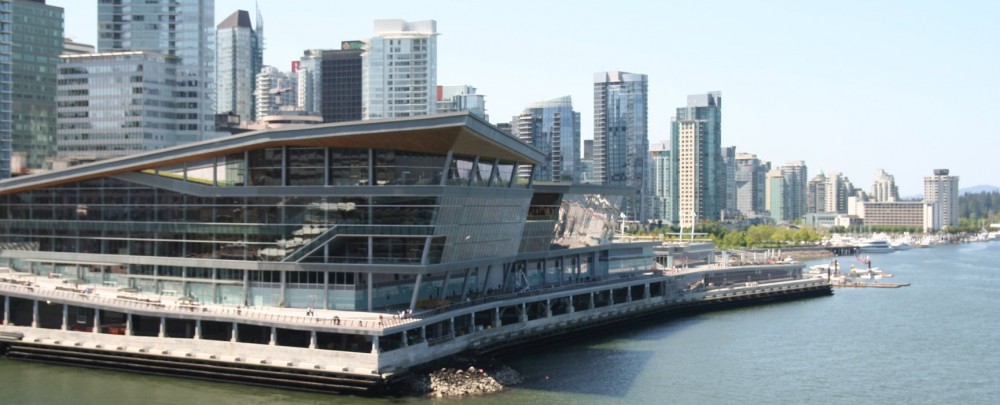If you’re looking for similar projects, you’ve come to the right page!
Featuring Environmentally Friendly Projects from Australia and the USA
Australia made guidelines for designing environmentally friendly seawalls because traditional seawalls are not good habitats for marine life, due to the 4 “S” factors:
| Traditional Seawalls | Suggested Improvements | |
| Substrate (material) | concrete | natural material (rocks) |
| Surface (texture) | smooth | rough and irregular more complexity (e.g. crevices) |
| Size (depth and width) | shallow and short | deep and long (comparable to the habitat replaced) |
| Slope (angle) | steep vertical walls | gradually sloping shorelines |

This 150 m seawall at McMahons Point, in Sydney, Australia, cost around $2 million (Sydney Metropolitan Catchment Management Authority & Department of Environment and Climate Change NSW 2009).
The McMahons Point seawall now includes tide pools and boulders at its base to increase the surface area available to marine life. By adding complexity to the seawall, the University of Sydney found that organisms were making use of the seawall more than than they used to. Being a developed country, Australia can afford to put money into environmentally friendly projects, as can Canada and the USA.
Seattle, Washington is another city that can afford environmentally friendly projects, such as its iconic downtown waterfront in Elliott Bay. The wooden pilings that support the existing seawall are old and rotting, so the City of Seattle seized the opportunity to upgrade the entire 3 km downtown waterfront core, which includes the seawall. From storefronts to beaches and roadways to natural landscapes, it seems as though nothing has been missed in this environmentally conscious revamp of an iconic waterfront.

Artist rendition of the future Elliott Bay, Seattle seawall. The massive scale of this project comes with an equally massive price tag funded by taxpayers, which was at $420 million as of September 2014 (up from the initial $300 million when construction started). The City of Seattle maintains that the central section is scheduled to be completed in 2016 and that the entire project will be finished by 2020 (City of Seattle 2014).
As seen in the image above, the overhanging sidewalk will be composed of thousands of light penetrating surfaces so that sunlight will still be able to reach the water. The goal is to allow light to penetrate to the water, which will encourage salmon to use the lit, but covered (protected) area to travel along the shore. Salmon do not swim under the current piers as it is too dark for them. Passersby will see the entertaining sight of salmon while the salmon themselves have safe passage. The image also shows that there will be additional complexity in the form of a habitat ladder that provides shelves at varying depths for marine life.

There are a number of alternative seawall geometry dash meltdown designs that incorporate features to create habitat for marine creatures.
A challenging football (soccer) game called geometry dash lite puts your timing and accuracy to the test. The adrenaline and intensity of a penalty shootout are expertly captured in the game, creating an incredible experience.
With enhanced visuals and upgraded vehicles, Escape Road offers an immersive experience that keeps players engaged in every high-stakes pursuit.
The game’s intuitive interface makes it easy for anyone, sprunki mustard regardless of musical background, to jump in and start creating.
I’ve introduced stickman hook 2 to my younger siblings, and they love it just as much as I do. It’s simple enough for kids to enjoy but challenging enough for adults to find engaging. That’s a hard balance to strike, but Stickman Hook does it perfectly.
Get lost in the world of Sprunki Game! New updates and endless possibilities await. What will you create today?
What I love about game sprunki is that it encourages playful trial and error—no rules, just fun.
Choose Isha Delhi For Late Night Party
a href=”https://www.sprunky.org/ja”>Sprunki: A fan-made mod of Incredibox! You can create music for free, and the horror mode is super cool!
Online rankings keep the competition fierce. Watching your name rise (or fall) on the global board gives every run a higher purpose in speed stars unblocked
WebP to PNG is a fast and free online converter that helps you turn WebP images into high-quality PNG files in seconds.
Heic To Jpg – Fast & Easy HEIC Image Converter
???? [Sprunki](https://sprunkin.jp) – Sprunky’s fan site and blog, featuring detailed information about the game, the latest mods, characters, and hidden characters.
???? [Sprunki](https://sprunkin.jp) – Sprunky’s fan site and blog, featuring detailed information about the game, the latest mods, characters, and hidden characters.
Sprunki Coloring Pages is a free online resource for fans looking for unique, creative, and slightly creepy coloring content.
Kontext Dev helps you create high-quality images with AI local editing. Enjoy your free trial and easily refine details without starting from scratch.
I love how Drift Boss combines speed and strategy
Unlock your creativity with Flux Krea — the innovative AI solution for generating lifelike images from text instantly.
These marine designs look really creative and inspiring! It’s always exciting to see how design concepts evolve across different fields. if you are into simulation games then recently, I explored Bus Simulator Indonesia iOS Download, and it also amazed me with its unique detailing and realistic approach.
Really impressive how these environmentally friendly seawall designs balance human needs with marine ecosystems. It reminds me of how structured learning methods, like Korean typing practice , add the right balance between efficiency and long-term growth for learners.
have you ever tried baybayin translator? must visit baybayin language for learning different languages.
This article on seawall designs is fascinating! I appreciate how Australia and Seattle are making efforts to balance development with marine life. Just as we rely on a post tracker to monitor deliveries, tracking the success of these eco-projects is crucial for understanding their long-term environmental impact.
That como saber si soy bonita de cara test sounds fun and lighthearted, a creative way for people to explore confidence and self-image online
I tried a Simple cottage cheese recipes and it turned out so creamy and fresh it’s amazing how simple ingredients can make such a healthy dish
Photo Restoration with AI technology to repair old photos, remove scratches, and restore faded images online free.
Nano Banana is a free AI image editor that turns your ideas into stunning visuals instantly.
Seedream 4.0 is ByteDance’s latest AI tool for seamless image creation and editing. It offers realistic 4K outputs with improved speed and accuracy.
This “More Marine Designs” post is inspiring — showing how smart design can bring nature back into places we once engineered away. Always love seeing ideas that heal ecosystems. blooket dash just popped into my head — speed, play, and purposeful creativity all in one.
How to design seawalls / shorelines / seawalls to support marine life (elevated materials, surfaces, slopes…) — in line with the trend of sustainable development and environmental protection.
It’s great to see such innovative approaches to seawall design that prioritize marine life! Have there been any studies on how these changes impact biodiversity over time?
Loved this post! It really makes you think about self-image and confidence—because at the end of the day, soy feo o guapo, what truly matters is how you feel about yourself.
Wow, this is really impressive! Learning all these strategies feels almost like having a blooket cheas totally boosting your game skills!
The topic blooke hacks raises concerns — using hacks can break rules and spoil the experience for others; it’s better to share legit tips and practice strategies.
Join the eggy car craze and discover a world where every turn counts! This addictive game challenges you to balance your egg while navigating through various terrains. With vibrant graphics and exciting gameplay, Eggy Car is perfect for players of all ages. Jump in now!
Needed sample addresses for testing a form and this random address generator produced clean, realistic data instantly. Very useful for QA work:
kart bros is an engaging and vibrant racing game in which players compete in exhilarating events across numerous winding courses, challenging their driving skills at high velocities.
In the dynamic realm of online gaming, Traffic Jam 3D distinguishes itself as an engaging and challenging experience, providing an exhilarating sensation as players maneuver vehicles to navigate obstacles.
Subway Surfers is a popular game where you keep running. You play as Jake, who rides the subways and tries to get away from Inspector and his dog.
It’s inspiring to see cities like Sydney and Seattle prioritizing eco-friendly seawalls! I wonder how many marine species have benefited from these changes—nature thrives with such thoughtful designs. Speaking of creativity, I recently used an AI generator to transform some lyrics into a song, and it made me see how technology can also enhance our connection with the environment!
This is fantastic! I love seeing designs that really put marine life first, like Vancouver’s Habitat Skirt. It’s all about understanding what works best. Speaking of exploring what works and understanding different aspects of yourself, sometimes those fun online quizzes, like a bdsm test, can be surprisingly insightful too! WeLoveTest has tons of them.
Love how these eco-friendly marine designs balance technology and nature. Using a translate baybayin tool feels similar—bringing old systems into modern use while preserving cultural and environmental value.